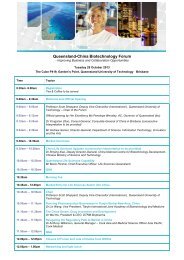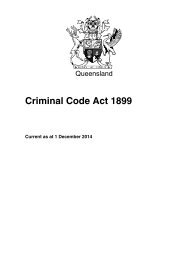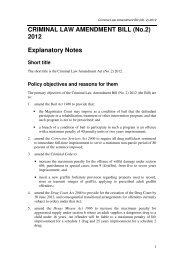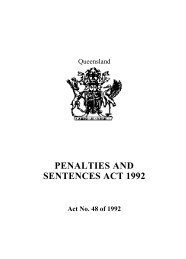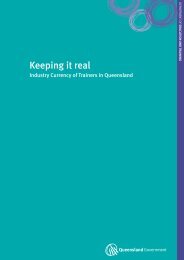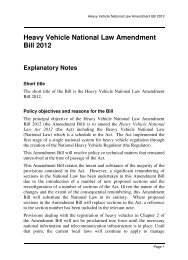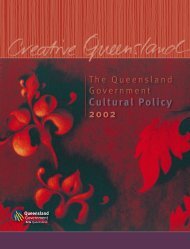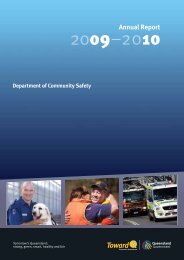Queensland Life Sciences Industry Report 2012 (PDF, 3.5MB)
Queensland Life Sciences Industry Report 2012 (PDF, 3.5MB)
Queensland Life Sciences Industry Report 2012 (PDF, 3.5MB)
You also want an ePaper? Increase the reach of your titles
YUMPU automatically turns print PDFs into web optimized ePapers that Google loves.
By David Blake, Editor of BioShares<br />
INDUSTRY COMMENTARY<br />
THE LISTED LIFE SCIENCES SECTOR IN AUSTRALIA<br />
— NOT ONE SIZE FITS ALL<br />
A neat one size fits all description of the<br />
state of Australia’s listed life sciences<br />
sector has become an impossibility<br />
since the GFC in 2008 began a process of<br />
constant damage to some companies but<br />
left others merely bruised and even some<br />
others unscathed. A high Australian dollar<br />
has not helped sales focused life science<br />
firms and healthcare system budgets<br />
and some export markets have weakened<br />
company earnings of late.<br />
What is known is that the number of listed<br />
life science companies has declined from<br />
a peak of 134 in 2008 to 100 in <strong>2012</strong>, with<br />
a contraction more likely to continue for<br />
as long as global economic conditions<br />
remain poor.<br />
The hundred or so life science companies<br />
listed on the ASX are a diverse group of<br />
companies in terms of market value,<br />
scale of operations, scope of business and<br />
market focus. There are 29 companies<br />
capitalised at less than $10 million, 49 are<br />
capitalised at less than $20 million and 18<br />
capitalised at less than $100 million. There<br />
are five companies capitalised at greater<br />
than $1 billion.<br />
The activities of ASX listed life science<br />
firms range from medical device<br />
manufacture and sales, vaccines and<br />
immune therapy product manufacture, cell<br />
therapy and wound healing development,<br />
assessment and diagnostic technologies<br />
including molecular, bio-sensor and<br />
algorithmic approaches, biological storage<br />
technologies, sleep apnoea management<br />
products and many more.<br />
Roughly 7-8% of ASX-listed life science<br />
companies are foreign firms lacking direct<br />
links to Australia. Biotech identity is a<br />
tricky classification issue given that quite<br />
a number of listed companies are US<br />
entities, which own operating subsidiaries<br />
in Australia.<br />
Investment in biotech stocks has been a<br />
stock picking activity for quite some time,<br />
a strategy which is a function of the time it<br />
takes for medical technology businesses to<br />
arrive at valuation inflection points,<br />
leaving many companies without vital<br />
news flow to attract investor interest.<br />
The Bioshares Index for example was down<br />
23.5% between June <strong>2012</strong> and June 2011.<br />
However, 22 stocks posted share price<br />
gains of greater than 20% for the same<br />
period. That’s not such bad going in<br />
dismal times.<br />
Ongoing key issues for investors in<br />
life science stocks include execution<br />
risk, otherwise known as financing<br />
risk, reflecting a company’s capacity to<br />
support the business objectives it has<br />
set itself. Investment flows have been<br />
biased towards later stage companies in<br />
the past few years, with companies such<br />
as Mesoblast, Alchemia, QRxPharma,<br />
Starpharma, Prima Biomed and<br />
Phosphagenics raising sizable tranches of<br />
capital to support pivotal clinical studies.<br />
New listings (the IPO market) have all but<br />
dried up with only one, Osprey Medical<br />
completed in <strong>2012</strong>, following three in 2011,<br />
and two in 2010.<br />
One risk that has recently been elevated<br />
in importance is regulatory risk. Several<br />
submissions to drug regulators from<br />
Australian firms, e.g. Pharmaxis, Mayne<br />
Pharma and QRxPharma, have been<br />
knocked back at the first round leaving<br />
both investors and the companies<br />
concerned in a state of shock. These<br />
first-cycle requests for more data can be<br />
expected to have a negative impact on<br />
investment in the sector<br />
The highlight for Australian life science<br />
investors in the last two years was the<br />
payment of a $100 million dividend by<br />
Acrux in April 2011, following the receipt<br />
of license-based payments from Eli Lilly<br />
for the testosterone drug Axiron. Rather<br />
than retaining the cash for another stage<br />
of business development, by paying<br />
shareholders a dividend, the board of<br />
Acrux elected to send a clear signal that<br />
investment decisions are ultimately the<br />
prerogative of shareholders.<br />
55



